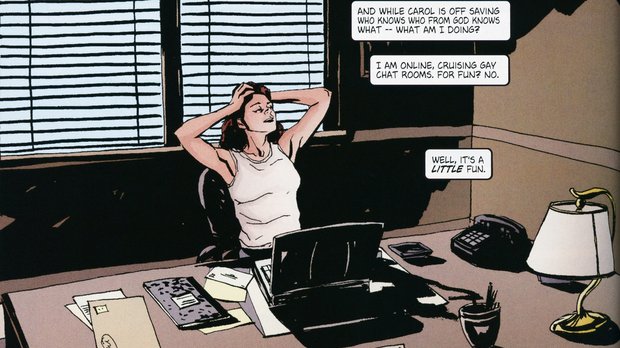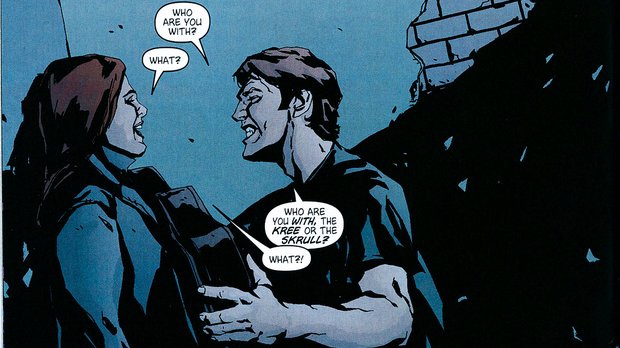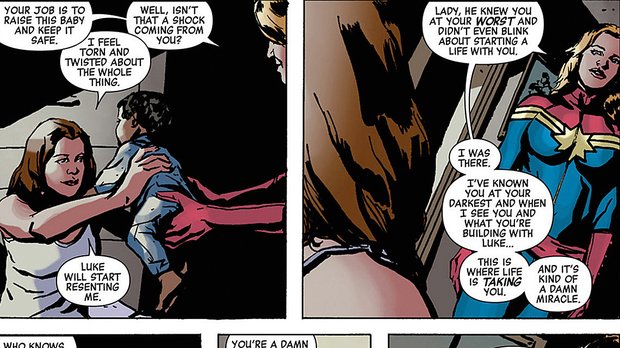Everything you need to know about Jessica Jones' comic book origins

After making her debut in Alias #1 in 2001, caped crusader-turned-private detective Jessica Jones has now followed in the footsteps of Daredevil to headline the second of Netflix’s quartet of Marvel series. “It’s like, ‘They’re really going to give this foul-mouthed PI her own show?’” laughs creator Brian Bendis. “Out of all the things that Marvel has got, you’d think that her show would maybe come after Night Thrasher! But here we are with this quite wonderful Jessica Jones show.”
Starting out in the mid 1990s as a writer/artist on series like Jinx, AKA Goldfish and Torso for independent companies like Caliber and Oni, Bendis’s first big break arrived in 1999 when he was recruited by Todd McFarlane to pen Spawn spin-off Sam And Twitch. Centring on a pair of homicide detectives, it proved to be an unexpected success, leading to Bendis helming another Spawn tie-in, Hellspawn. Having already been offered the opportunity to reinvent Daredevil for Joe Quesada’s Marvel Knights imprint and charged with taking Peter Parker back to his roots in Ultimate Spider-Man, he quit with Hellspawn #10 after becoming disenchanted with its “dark horror” only to then be fired from Sam And Twitch as well.
“Joe Quesada then called about 30 minutes after it happened, and I said ‘the weirdest thing has just happened’,” recalls Bendis. “And he said ‘that’s weird because one of the things I wanted to talk to you about was doing a crime comic for us, so why don’t you take your Sam And Twitch time and put it towards creating a ground-level, crime book for Marvel?’”

Initially Bendis contemplated exploring a different side to Jessica Drew, aka Spider-Woman. “But as I was developing it, it quickly revealed itself to not be about her at all,” he continues. “It didn’t match her background or continuity, and revealed itself to be a whole new character. But I didn’t know how to pitch it because in my head, it was rated ‘R’ and Marvel didn’t do those kinds of books at the time.”
Originally called Marvel Incorporated, it prompted Marvel’s then-Vice President Bill Jemas to launch the mature readers-focused Max line, although not before yet another name change. “My other suggestion was Alter Ego, but that was the title of Roy Thomas’s magazine, so we came up with Alias instead,” says Bendis. “We were off and running and then four months later, there were all these billboards around town for JJ Abrams’ TV show Alias and I went, ‘Shit!’”
In need of an artist, Bendis turned to fellow Cleveland Institute of Art alumnus Michael Gaydos. “We didn’t want her to be a big-boobed Bad Girl, as stuff like Lady Death was big at the time, and that wasn’t the kind of story we were telling,” explains Bendis, who, despite signing a contract to create Jessica Jones for Marvel before Gaydos was involved, has ensured that the artist receives equal credit on the Netflix show. “Without the visual component that he brought, which was her true humanity, she wouldn’t exist or feel the way that people think of her. When people see the TV show, even though Krysten Ritter looks different to our Jessica, she is really living and breathing Michael Gaydos’s Jessica Jones.”

With Bendis wanting her to be drawn “like a real person”, Gaydos based Jessica on his now ex-wife. “Alias was such a strong character-driven book and it was important to me to really make the expressive nature of these characters believable, and especially Jessica,” says Gaydos. “I think being in a close relationship for a long period of time really helped me bring the subtle nuances of Jessica to life. Brian’s writing was also perfectly realistic and effortless, so I attempted to get that same type of feel in the art.”
Get sneak previews, exclusive competitions and details of special events each month!
Describing it as “the superhero version of Chinatown”, Alias’s distinctive mash-up of the crime and superhero genres predated similarly themed series like Gotham Central, which itself gave rise to the Gotham TV series last year. “My notes at the time included things like ‘what if you’re not a very good Avenger?’” says Bendis, who drew on an interview with Blade Runner actress Sean Young that he’d read in Premiere magazine. “She was talking about how when you’ve been on the A-list and since been get kicked off, you still know where all the good parties are, you just don’t get invited to them anymore. It would be like a superhero knowing where Avengers Mansion was but not getting that ‘Avengers Assemble’ call. With Jessica, one of those big supervillain bust-ups didn’t go her way and it ruined her.”
Forming her own agency, Alias Private Investigations, Jessica re-establishes herself as a detective-for-hire and gradually learns to value her abilities again. “She doesn’t see herself as a superhero or even a hero, but we see in the early issues of Alias that she will pursue a case whether she gets paid or not,” he says. “By any definition, that’s heroic, and writing about her self-discovery and the healing of her broken wings and wounds was something worth writing about. It also allowed me to create this character that fitted perfectly into the world of the books that I loved in the ’70s and ’80s like Power Man And Iron Fist and Ms Marvel. It was fun – even though this is a swear word in comics – to retcon her into the Marvel Universe, and find her place in it, and be so reverential that she feels right at home at the same time.”

Indeed, Bendis ended up teaming Jessica with erstwhile Power Man, Luke Cage. “That was a matter of figuring out, ‘If Jessica is down here at this lower level of the Marvel Universe, who would she be hanging around and having run-ins with?’ Because she’s going to bump into Danny Rand (Iron Fist), Jessica Drew and Matt Murdock, as they would be her peer group,” explains Bendis.
“Luke also had a run of bad luck for a while and pulled himself together. In my life, I’ve found that people who have been through similar situations end up gravitating towards each other, even though it’s not necessarily obvious why they’re so connected. I had written her origin storyline – which was the last storyline – first, without showing it to anybody. I knew where Luke landed in that story, so it was easy to open the first issue with them having a falling out and then trying to see if they could build something back up.”
If that wasn’t enough, Bendis presented the often-tempestuous partners with their toughest challenge yet in the form of a baby. “Jessica had gotten to a place where she had healed and gotten over the big one that had knocked her out,” says Bendis. “Around that time, my wife got pregnant even though the doctors told her that she couldn’t. Anybody who has been through a pregnancy, even if it isn’t a troubled one, knows that it’s very scary. You realise that no matter how self-involved or self-loathing you are, you have to stop that shit because there’s this little thing that needs you. So Alias was filled to the brim with my neurosis about that, as I just projected it onto Luke and Jessica.”

With Alias coming to a natural conclusion in early 2004, Jessica’s next move was to become a superhero correspondent for the Daily Bugle in The Pulse, during which time she also gave birth. With both her and Luke playing pivotal roles in 2006’s Civil War event storyline, Jessica’s career then turned full circle as she joined the ranks of the Avengers. “I just love second chances and comebacks,” laughs Bendis.
“I thought, ‘If we can write Luke and Jessica as a couple and put a baby in their hands, putting them in Avengers Mansion and having them still be themselves would be fascinating.’ There’s a sense with Luke and Jessica that even after all these years, anything can happen to them. It could all go to hell at any minute because they’re both wired for that to happen and they’re in a very dangerous place. But they still have to live their life and try and build something together.”
Go behind the scenes on the set of Jessica Jones in the latest issue of SFX on sale now. If you subscribe by November 22, 2016, you can get 3 issues for just £3, including our Massive 2016 Preview issue (on sale 9 December).
Stephen is an entertainment journalist based in London. His bylines have appeared in the New Zealand Herald, SFX Magazine, GamesRadar, the Judge Dredd Magazine, and 2000AD Ultimate Collection.


